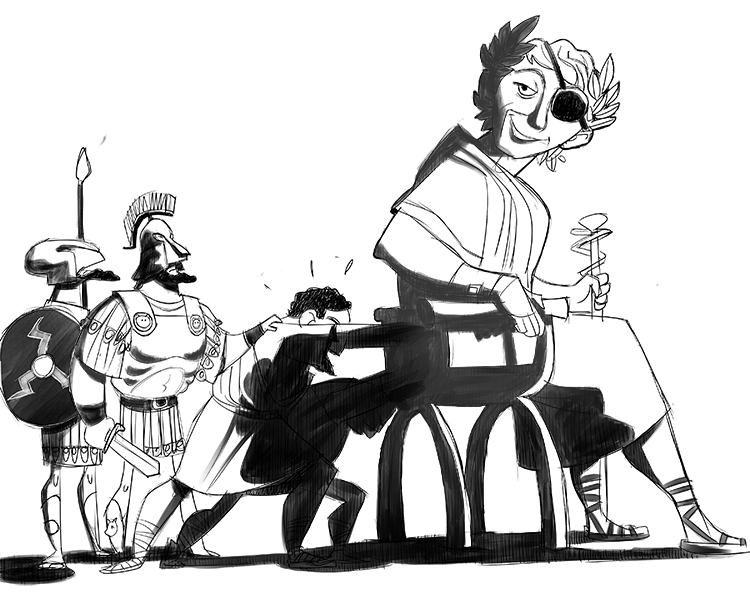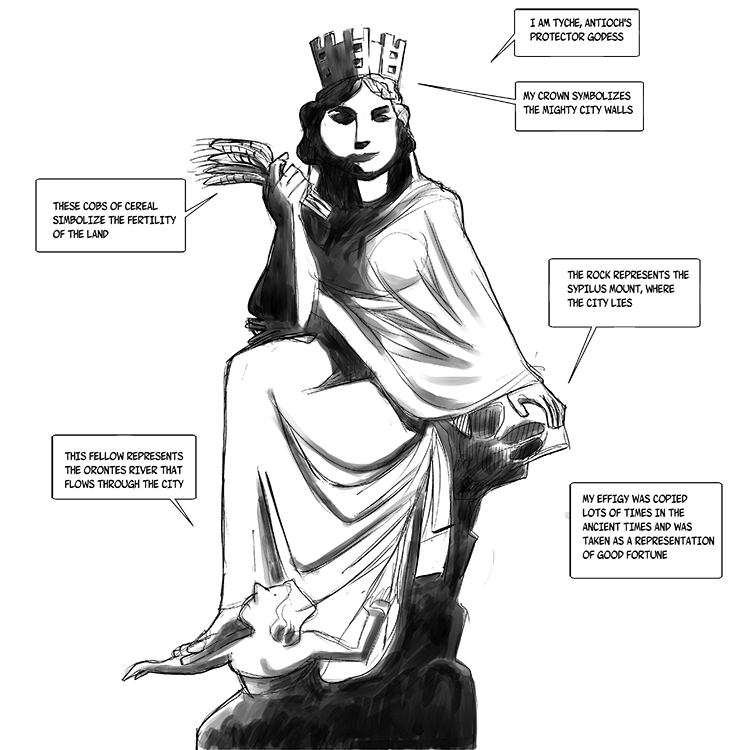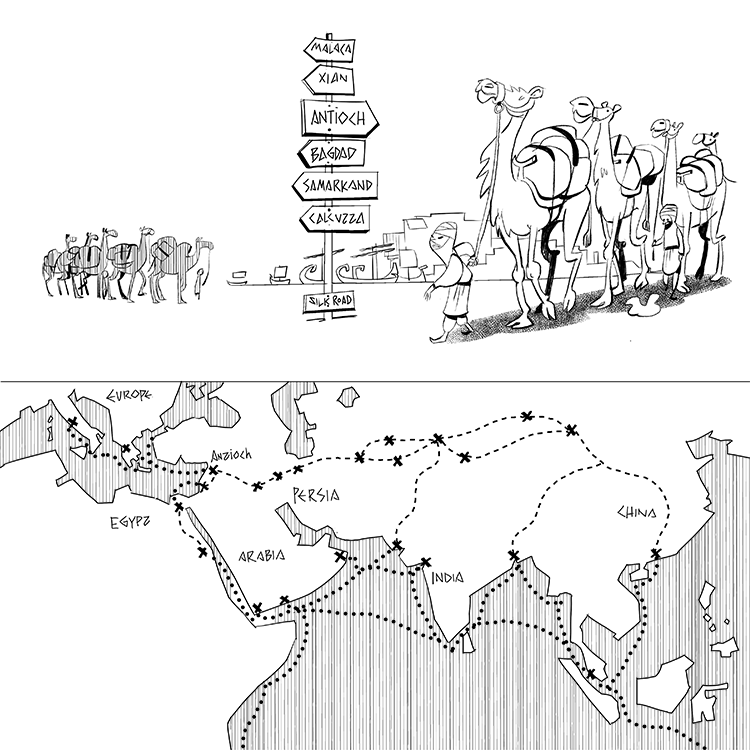Starting in 336 BC, Alexander the Great moved through the ancient world like a wrecking ball. He began in Greece by reasserting his father’s conquests and keeping the many Greek city-states under his control. But less than ten years after that, he’d conquered Egypt and Persia and brought his armies all the way to India.
At the time, this created the world’s largest empire.
However, when Alexander died in 326 BC, his empire died too. Chaos — mainly in the form of war — came next. And when the dust settled, the world looked very different.
The Greeks, not the Persians, emerged as the dominant culture in the Mediterranean and western Asia. Through this dominance, Greek culture spread throughout the world. This created new, powerful cities, and set the stage for the Roman empire to emerge.
This period, from roughly 323 BC until 31 BC, is known as the Hellenistic Era. Coming from the Greek word for Greece — hellas — it was the height of Greek influence on the ancient world.
The Beginning of the Hellenstic Era: The Diadochi and their Wars
Alexander the Great’s death in 323 BC shook the entire ancient world. He conquered so much so quickly that he never established a government for his empire. The fact that he never stuck around in any of his conquered territories didn’t help either.
Instead, he left generals in conquered lands to rule, a group that became known as the Diadochi. To do this, they often just continued along with what the Persians had done, which did little to consolidate Alexander’s power.
So, when he died, it was unclear who would take over his empire. Yet everyone wanted it.
To solve this problem, the Diadochi did what powerful men have done throughout history: they went to war.
Over the next 30 years, the various generals from Alexander’s army fought amongst themselves. Each one was hoping to declare themselves emperor. But, in the end, no one managed to take control over all of Alexander’s conquests.
Instead, three different kingdoms emerged, one based in Greece, one based in Egypt, and another based in what had been Persia.
Together, these three rulers established new dynasties that would rule the ancient world for much of the next three centuries. And this stability allowed Greek influence to expand and assert itself in lands very, very far from what we now consider to be Greece.
The Three Main Kingdoms of the Hellenistic Era
After the dust settled from the Diadochi Wars, three main kingdoms appeared in the place of Alexander the Great’s empire.
However, the borders of these kingdoms remained far from fixed. Throughout the nearly three centuries of the Hellenistic Era, war was constant. For starters, different states and former Persian satraps (their term for district) rebelled to try and gain their independence. Plus, the various kingdoms that emerged from Alexander’s empire frequently invaded each other. They just didn’t want the war to end!
Yet in spite of all this turmoil, three dynasties remained intact for nearly the entirety of the era.

Antigonid Dynasty
The first of these three dynasties was the Antigonid dynasty, named after Alexander’s general Antigonus I “Monopthamalus” — Antigonus the “One Eyed.”
While several attempts were made to dethrone Antigonus and his successors, they failed, and the dynasty lasted until the Roman invasion during the 2nd Century BC.
In general, the Antigonid dynasty got the smallest piece of Alexander’s pie. They ruled from Macedon, the conqueror’s homeland, but their territory included just Macedon (in Northern Greece) as well as some land in Ionia (on the southwestern coast of Turkey).
Macedon also claimed the rest of mainland Greece as part of its domain, but major Classical cities, such as Athens and Sparta, remained mostly independent. But they were no longer super powers like they once were. Shells of their former selves, these cities had to play nice with Macedon or face the consequences.
Overall, mainland Greece took a backseat during this part of history. Ravished by wars from the previous centuries, the cities were no longer the same. Plus, with so many other places now controlled by Greeks, there was incentive for people to move around. Many Greeks from the mainland relocated to Egypt or Syria.
This downgraded the role of Greece in this part of Greek history. But it also helped spread Greek influence to the rest of the ancient world, completely reshaping it in the process.
Ptolemaic Kingdom
The next major political unit to emerge from Alexander the Great’s empire was the Ptolemaic dynasty, which occupied Egypt and some parts of Palestine and Phoenicia. It was named after Ptolemy I, Alexander’s general. But the name also came from the fact that all of Ptoloemy’s successors also took that name. So much for being creative…
For Egypt, the arrival of the Greeks brought about a sort of cultural revival. Before Alexander the Great, the once-powerful civilization of the Nile was nothing more than a Persian district. The Persians suppressed much of Egyptian religion and culture, and so life in general was not good.
Therefore, when Alexander the Great came, the Egyptians welcomed him as a liberator.
Both he and Ptolemy took steps to win favor with the local Egyptians. Mainly, they adopted local customs and restored prominence to Egyptian religious beliefs. This brought peace and stability to the region and helped it prosper once again..
In addition, Ptolemy invested heavily in the city of Alexandria, which was founded after Alexander’s conquest and made the capital of Ptolemaic Egypt. Due to its strategic location within the Nile Delta and next to the Mediterranean, it soon became a center for trade and learning.
The rise of Alexandria was yet another reason why Egypt returned to glory during the Hellenistic Empire

Seleucid Empire
The largest of the three main kingdoms to emerge from the Diadochi Wars was the Seleucid Empire. Named after Seleucis I Nicator, it mostly resembled the Persian Empire from the times before Alexander the Great.
At its height, it stretched as far east as the Indus River and as far west as modern Turkey and Israel, sharing a border (which was highly contested) with both the Antigonid and Ptolemaic dynasties.
Its capital, Antioch, which is in modern-day Syria, lay directly on the Silk Road — the trade route connecting Europe with China — and so it flourished as a commercial hotspot.
In addition, the Seleucid empire was a top destination for Greek immigrants, which led to the formation of a significant Greek population in western Asia.
Greek language and customs were the standard during this time, though Seleucis and his successors were generally tolerant of local traditions.
As the largest kingdom to emerge in the Hellenistic Era, the Seleucid empire also had the most number of enemies. Its western border was frequently shifting thanks to near constant conflict with the Ptolemaic empire in and around Gaza and Palestine. To the northwest, it had to contend with the Antigonid dynasty in Turkey. In the northeastern parts of the empire, ambitious governors made it difficult for the Seleucid dynasty to retain control.

Greco-Buddhism
The Buddha is often portrayed surrounded by his guides and protectors. In Greco-Buddhist sculptures Hercules appears sometimes as one of them.
Eastern Hellenism: Greco-Bactrian and Indo-Greek Kingdoms
While the Antigonid, Ptolemaic, and Seleucid dynasties made up much of Alexander’s large but short-lived empire, they were not the only kingdoms that existed during the Hellenistic Era.
Instead, wars amongst these great powers opened the door for new kingdoms to emerge, which stretched and transformed the extent of Greek influence in the ancient world.
For example, the region of Bactria, in modern-day eastern Afghanistan/Pakistan, declared its independence from the Seleucid empire in c. 250 BC under a man named Diodotus I, a powerful Greek noble who claimed ancestry to Alexander the Great.
This created a new kingdom that fused Greek and central Asian cultures.
Shortly thereafter, the Ptolemaic empire invaded the Seleucids and captured its capital, Antioch. This significantly weakened the Seleucid’s grip on control, and another region of its empire, Parthia, located in what is now northeastern Iran and Southern Turkmenistan, seized this opportunity and declared independence. From there, the Parthians invaded more Seleucid land, conquering it and bringing the Seleucid Empire to an end.
This put control of Iran back into the hands of the Iranians (the original ethnic group of Persia) and dramatically reshaped the landscape of the Hellenistic Era.
For one, it cut off Bactria, which was ruled by Greeks, from the rest of the Greek world. This forced the Greco-Bactrian kingdoms to look east to expand, bringing Greek and Eastern cultures into contact with one another and forming new cultural connections.
Specifically, the Greco-Bactrians had lots of contact with Buddhists from the east, many of whom were traveling along the Silk Road trying to share their wisdom and attract followers.
This, along with the establishment of Indo-Greek kingdoms further east towards the Indus River valley, led to the emergence of Greco-Buddhism. This was the cultural syncretism (mix) between Hellenism and Buddhism.
The mixture of these two cultures caused many ethnic Greeks to convert to Buddhism, but it also brought a heavy Buddhist influence into Greek culture back in the west.
For example, three major schools of philosophy that emerged in the Hellenistic Era — cynicism, skepticism, and cyrenaicism — all may have been influenced by Buddhist thought and teachings.
Just another example of how human history is really a story of cultural mixing and cross-boundary connection. And an important reminder that our differences are never quite as large as they seem.

The Silk road
The silk road was a network of land and sea trade routes that criss crossed the ancient world. Many of the great cities of antiquity flourished because of it.
The Rise of Antioch and Alexandria
Another major impact of the Hellenistic era was the rise of Antioch and Alexandria, the capitals of the Seleucid empire and Ptolemaic Egypt, respectively.
Alexandria was founded by Alexander the Great when he conquered Egypt, and he immediately made plans for it to flourish. He ordered the construction of the Great Library and Great Lighthouse, both of which would help turn the city into a bustling center for trade and learning.
Artists, philosophers, writers, and merchants would all spend time in Alexandria, increasing its wealth and prominence and helping Egypt prosper once more. Later, Alexandria became the capital of the Roman province in Egypt and served as an important political center for centuries.
A similar story took place in Antioch, though this city was founded by Seleucid. Located on the Mediterranean coast in southern Turkey, near to the border with modern day Syria, he designed it to look like Alexandria. It was constructed using a grid system (a relatively new concept at the time that we still use today), and also took steps to make it a powerhouse for trade and learning, such as building world-class universities and libraries.
It helped that it was located right on the Mediterranean Sea, directly on the path of the Silk Road. Therefore, Antioch was influenced by both European and Asian customs, and became a true cosmopolitan city.
Because of its wealth and strategic position, the Romans loved Antioch, and as they were establishing their empire, they chose it as their eastern capital. This helped enshrine this relatively new city into the annals of ancient history.

Philosophy During the Hellenistic Era
During the Hellenistic Era, all aspects of Greek culture spread and flourished around the Mediterranean, North Africa, and western Asia. This meant language, but also art, styles of government, food, and much more.
One particular aspect of Greek culture that really prospered during this time was philosophy. During the Classical Era, philosophy assumed a prominent role in Greek culture, but most of this originated in Athens.
However, during the Hellenistic Era, philosophers came from the eastern kingdoms of Bactria and India to Italy, Egypt, and more. This diversity introduced new ideas to Greek philosophical thinking, leading the formation of several entirely new schools. Some of the main traditions that emerged during this time were Epicureanism, Stoicism, Skepticism, Cynicism, and Cyrenaicism.
These branches of philosophy differed quite a bit from those that emerged during the Classical Era in that they focused mainly on the individual instead of society as a whole.
The Classical philosophers were greatly concerned with what made up an ideal society, how people should be ruled, and what was right and what was wrong.
However, during the Hellenistic Era, the focus became on how to achieve happiness and “the good life.”
This was partly due to the prosperity of Greek culture at the time. For the Greeks living during this period, their dominance across such large swaths of territory would have made it seem like they’d reached the pinnacle of society. But the success of a civilization does not always lead to individual happiness. This paradox seems to have been at the base of the philosophical inquiries at the time, leading to new ways of thinking that are still very much present today.
Hellenistic Greece: The Prequel to Rome
Throughout the 3rd century BC, a little city in Italy — known back then to the Romans as Italia — started getting more and more powerful. First, it fought several wars with Carthage (located in modern-day Tunisia). Then it made agreements with the cities of mainland Greece to protect them.
Little by little, the Romans expanded east. They began by conquering Greece and Egypt, then Parthia, and later the Greco-Bactrian and some of the Indo-Greek kingdoms.
This empire would then last for centuries and laid the foundation for much of modern Western society. However, part of the reason the Romans were able to do this was because of their efficient bureaucracy, which was made possible in part thanks to the structures put in place during the Hellenistic Era.
In many places, the Romans did a simple “plug and play.” They removed the existing leader, put one of their own in, and left everything else intact. This made it much easier to rule and helped contribute to the stability of the Roman empire.
So, while the Hellenstic Era lasted barely three hundred years, it brought about profound changes in the ancient world that laid the groundwork for modern civilization. Once again, it is clear that today’s world would not be the same were it not for the Greeks.
Written by Matthew Jones
Illustrated by Pablo Velarde Diaz-Pache
